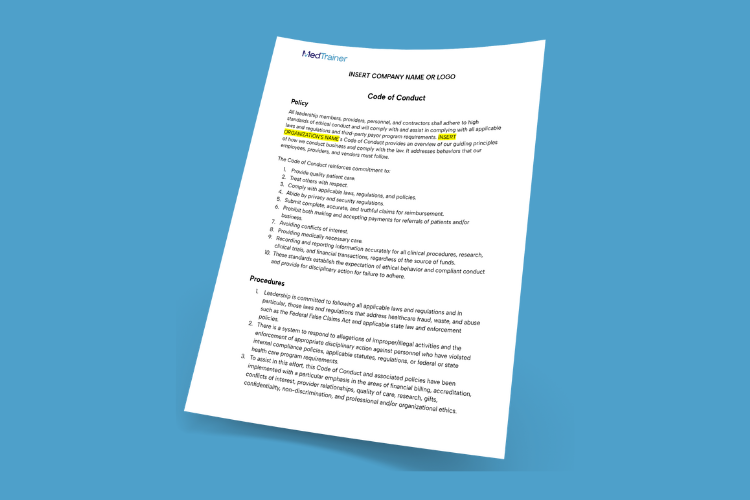Healthcare fraud, waste, and abuse is a costly problem for both public and private payers. The National Health Care Anti-Fraud Association estimates financial losses due to healthcare fraud could be as much as $300 billion annually. It’s why they’re dedicated to strong enforcement and tough penalties.
The vast majority of providers adhere to high ethical standards, provide quality care, and submit appropriate claims for payment. They’re educated on applicable laws and trying in good faith to adhere. For those who are not, there are five main federal laws they are likely violating related to healthcare fraud. Non-compliance with these regulations can result in jail time, large fines, and even loss of license.
Keeping compliance and fraud prevention top of mind can help to protect both your organization and its staff. In this article, we’ll review the most effective compliance tactics to reduce fraud and explore the value of compliance software in preventing fraud, waste, and abuse.

Download a ready-to-use and customizable Code of Conduct.
Common Types of Healthcare Fraud, Waste, and Abuse
Fraud is a straightforward concept that, unfortunately, can manifest in many ways within a healthcare organization. From sophisticated Medicare fraud to a rising prevalence of telehealth fraud, healthcare organizations need to be diligent in understanding these threats.
Here’s a look at some of the common types of healthcare fraud:
- Double billing: Submitting multiple claims for the same service.
- Unbundling: Billing for each step of a procedure as if they are separate.
- Phantom billing: Billing for a service or supplies the patient never received.
- Upcoding: Billing for a more expensive service than the patient received.
- Medically unnecessary services: Ordering services, such as excessive lab testing, without assessing the patient’s needs.
Keep in mind that these are just examples of provider fraud! The scope of potential healthcare fraud is vast and can span patients, third-party service providers, and general bad actors out to abuse the system.
Design Your Compliance Program To Fight Fraud
Healthcare compliance programs play a crucial role in preventing fraud, waste, and abuse in the healthcare system. The seven components of healthcare compliance lay the groundwork to ensure employees adhere to legal and ethical standards, thereby minimizing the risk of unlawful activities and enhancing the overall integrity of healthcare operations.
- Establishing Policies and Procedures: Compliance programs create clear expectations, policies, and a code of conduct for all aspects of healthcare operations, from billing practices to patient care.
- Designating a Compliance Officer: Compliance officers provide expert oversight and ensure the organization’s practices are in full compliance with all legal requirements. Look for a Certified Fraud Examiner for even more expertise.
- Training and Education: Regular training for employees on the latest laws, regulations, and company policies is critical. This helps ensure that everyone understands what constitutes fraud, waste, and abuse, and how to avoid these pitfalls.
- Developing Effective Communication: Encouraging open communication and proactive incident reporting within an organization promotes transparency. When employees feel they can openly discuss issues or concerns without fear of retaliation, they are more likely to report suspicious activities or seek clarification on compliance matters.
- Auditing and Monitoring: Compliance programs include rigorous auditing and monitoring of financial and clinical operations to detect irregularities that might indicate fraud or abuse.
- Enforcement and Discipline: Employees who violate compliance standards face consistent, fair, and firm action, which serves to deter non-compliance by emphasizing the organization’s commitment to lawful and ethical conduct.
- Responding to Offenses: Once a potential compliance issue is identified, it’s crucial to investigate the issue promptly and, if necessary, make corrections to prevent future occurrences.
4 Ways Healthcare Compliance Software Simplifies Fraud Prevention
Technology is an incredible tool to reduce fraud within healthcare organizations. Trying to keep providers on the straight and narrow using spreadsheets, or even multiple systems, is very difficult. You’re losing valuable data, tracking, and time that could result in much worse if you miss the tell-tale signs of fraudulent activity.
Here are four ways healthcare compliance software simplifies fraud prevention:
1. Convenient and engaging education
A learning management system makes it easy for employees to complete courses within their schedule. Choose a vendor who regularly updates the content and offers post-course assessments to keep your staff’s attention. Administrators get comprehensive tracking and customizable reporting so you know if employees have not completed the course or passed the quiz. This could be critical information in the event of fraud at your facility.
2. Regulatory adherence
Healthcare-specific learning management systems offer many fraud-related courses that meet state and federal regulations. Choose providers, such as MedTrainer, who are focused on keeping the courses up-to-date when regulations or trends change. These training experts also work to optimize the courses so employees don’t need to complete unnecessary training.
3. Accessible policies
It’s easy for employees to ignore a paper policy that they’ve stuffed in a drawer. It’s harder to overlook policies that are easily accessible online and clearly show acknowledgment. Compliance software puts all policies and documents into an organized, cloud-based platform. Full-cycle policy management takes it to the next level, offering electronic board approvals and signatures, expiration reminders, and employee acknowledgement and tracking.
4. Truly anonymous reporting
Encouraging internal reporting without fear of retaliation is a hallmark of effective compliance programs. Incident reporting software that does not track IP addresses makes online incident reporting truly anonymous. Plus, the reporting capabilities make it possible to identify the departments and locations that are receiving the most — or least — fraud reports.
Simplify Compliance and Fraud Prevention With MedTrainer
MedTrainer’s all-in-one compliance software is built specifically for healthcare organizations to manage their unique needs, such as healthcare fraud prevention. Combining learning management system, policy management, online incident reporting, and more reduces barriers for employees.
Learn how MedTrainer can help you streamline fraud prevention.
